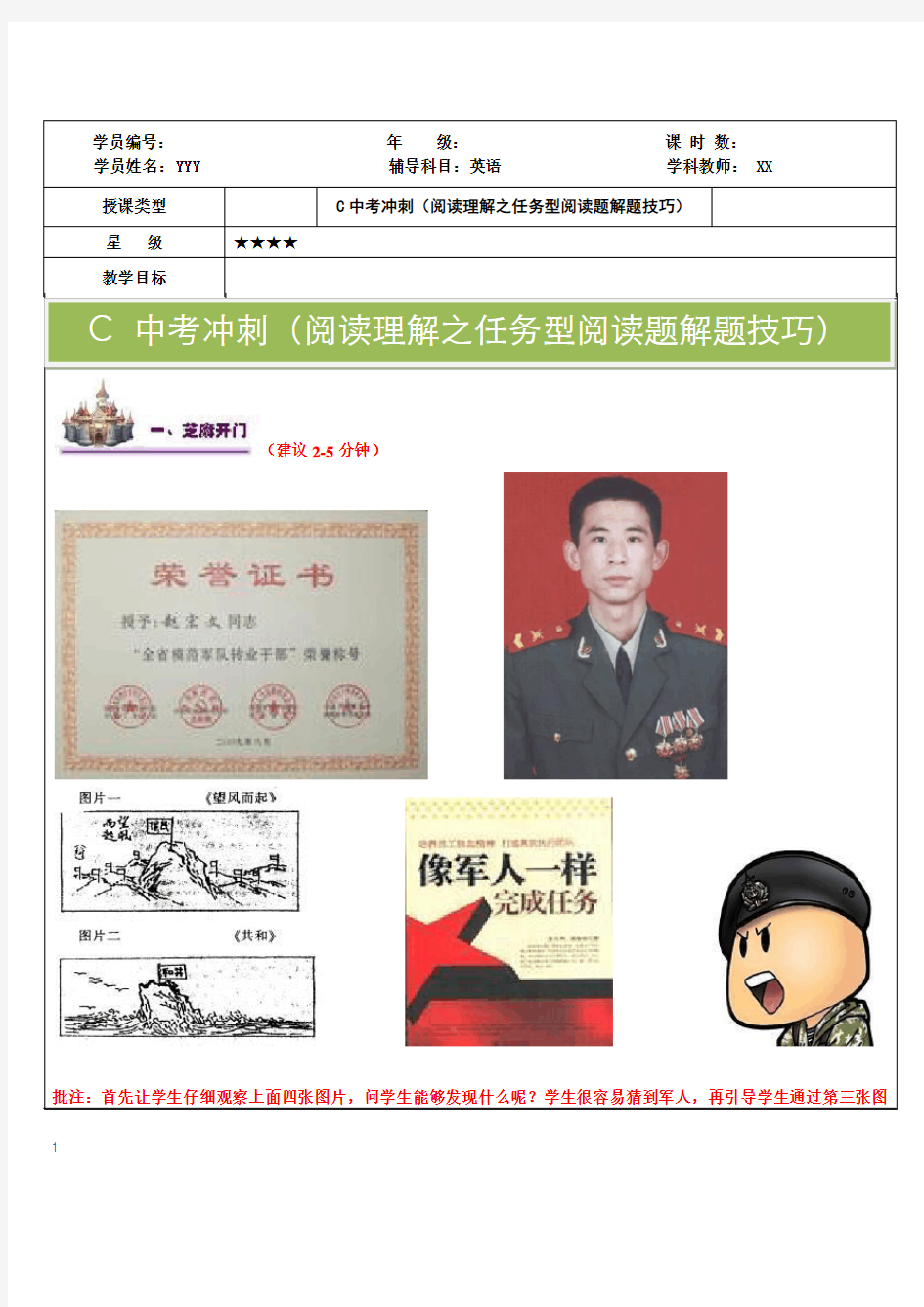初三中考英语阅读理解专题之任务型阅读题解题技巧讲义教案(含练习答案)

- 1、下载文档前请自行甄别文档内容的完整性,平台不提供额外的编辑、内容补充、找答案等附加服务。
- 2、"仅部分预览"的文档,不可在线预览部分如存在完整性等问题,可反馈申请退款(可完整预览的文档不适用该条件!)。
- 3、如文档侵犯您的权益,请联系客服反馈,我们会尽快为您处理(人工客服工作时间:9:00-18:30)。
C 中考冲刺(阅读理解之任务型阅读题解题技巧)
(建议2-5分钟)
批注:首先让学生仔细观察上面四张图片,问学生能够发现什么呢?学生很容易猜到军人,再引导学生通过第三张图1
发现什么呢?和学生可以探讨一下中国八年抗战历史,在中共带领下顺利完成了8年抗战,取得任务的胜利。激发起学生的历史兴趣后,可以引申出本课重点任务性阅读。告诉学生,做任务型阅读就如同士兵打仗,我们要像士兵们一样带着任务,掌握一定技巧,携带必要的军事设备才能出奇制胜。
(建议20-25分钟)
➢什么是任务型阅读?
答曰:任务型阅读是“阅读理解”的另一种形式,考查学生归纳概括能力和语篇结构理解能力。其内容涉及广泛,要求学生在阅读理解的基础上,完成一项任务或解决一个问题。所以“任务型阅读”是介于阅读理解和写作之间,其任务已不同于阅读理解中的选择题或书面表达,而是在理解文字的基础上,完成相应的图表或文字练习,从而有效地测试学生用英语“做事”的能力。
➢中考任务型阅读的常见类型
答曰:回答问题型
也就是给出一篇短文,题后设计几个问题(一般六个题)。这种题型既考查学生的阅读理解的能力,又考查学生的在文章中提取信息的能力。要求学生根据问题在文章中找出能回答问题的关键句子,或者需要自己组织语言回答问题;有的题目设计出一两个翻译题等。细读问题要求,完成任务。在明白题意和文意的基础上,仔细阅读后面的题目要求,根据实际情况去完成所要求的任务。总之,这类题型要求学生要有很好的阅读理解和归纳总结的能力。
➢读题的过程中应注意:
3审:审题目
审内容
审语法
解题技巧
1. 直接获取答案型
例题:
Have you ever heard the story of the four-minute mile? Many years ago, people believed that it was impossible for a human being to run a mile in less than four minutes until Roger Banister proved it wrong in 1954.
What happens if you put an animal in a pond? Any animal, big or small, will swim its way through. What happens when someone, who does not know how to swim, falls in deep waters? They drown. If an animal who hasn’t learned swimming could escape by swimming, why not you? Because you believe you will drown while the animal does not.(2013年虹口一模)
2
93. Who first ran a mile in less than four minutes?
_________________________________________________________________.
Key: Roger Banister
批注:引导学生在题干中找出问题关键who,然后划出题干重点词“less than four minutes”. 可以在文章第一段定位,然后在文中划出与题干相对应的词,我们可以直接找出答案“Roger Banister”,提醒学生如果详答必须注意此题的时态。
总结:细读文章,找出信息
2. 间接获取答案型
例题:
In the afternoon, she left the studio (录像室) and went back to where she had met them, hoping they would be there.
When she got to the place, she saw they were singing just the way they had been singing the day before.
“Why didn’t you come to the studio this morning?” the director asked the old man.
“I was too nervous,” the old man said. “I thought you would be angry when you found out the truth.”
“What truth?” the director demanded.
“Well, the horse can’t sing a note,” the old man said apologetically. “You see, the dog is a ventriloquist(口技者).”
(2013黄埔一模)
97. What was the truth of the performance by the horse and the dog?
_______________________________________________________
Key:The truth was that the horse couldn’t sing a note and the dog was a ventriloquist.
批注:引导学生在题干中划关键问题truth, 到底真正的事实是什么呢?先阅读下全文,我们很快就能在文中发现truth 这个词,但是答案不是能够直接获取的,我们需要自己去整理下语言,把答案拼凑起来。文章最后一段就是答案,注意时态。
总结:纵观全文,对比图表,找出差异,适当变形
3. 综合归纳型
例题:
Mo Yan, the winner of the Twenty-Twelve Nobel Prize for Literature, is extremely popular nowadays. The Chinese writer is good at combining folk(民间) stories, history and modern events in his writings.
When Mo Yan learned he had won the award, he was "shocked and frightened", as he told reporters in front of the TV screen. He received his Nobel diploma, a medal and more than one million dollars prize money at a ceremony in Stockholm in December 2012.
Mo Yan is a leading author of modern Chinese novels. He is fifty-seven, and his real name is Guan Moye. Mo Yan means "Don't Speak." The writer said he chose the name to remember to stop his tongue from getting himself in trouble. Mo Yan began his career as a writer in the reform and opening up period, and he published dozens of short stories and novels in Chinese. His first novel was "Falling Rain on a Spring Night", published in 1981.
Mo Yan used to write from memories of his youth. He also set many of his story scenes in the area where he was born - Shandong Province in northeastern China. Mister Mo's book "RedSorghum (红高梁)," is an example. It is about the extreme violence (极端暴力) in rural eastern China in the nineteen twenties and nineteen thirties. The story describes the violent culture of
3
